Leadership Project: ELD Program
Leadership Goals for ALAS in Supporting English Language Learners
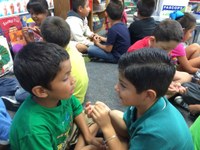 Data collected by the Lawndale Elementary School District (LESD) indicated the importance of English language learner reclassification and its correlation to students’ academic success in Lawndale. Many of the long-term English learners in the district were not gaining the yearly one level growth on the California English Language Development Test (CELDT) as desired. A singular, common ELD program across the district was deemed necessary to provide English learners in Lawndale with equitable access to the curriculum. Leadership Project Powerpoint
Data collected by the Lawndale Elementary School District (LESD) indicated the importance of English language learner reclassification and its correlation to students’ academic success in Lawndale. Many of the long-term English learners in the district were not gaining the yearly one level growth on the California English Language Development Test (CELDT) as desired. A singular, common ELD program across the district was deemed necessary to provide English learners in Lawndale with equitable access to the curriculum. Leadership Project Powerpoint
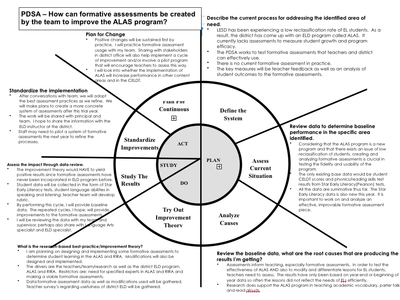 The initial goal for the leadership project was to analyze the district’s newly adopted and developed English Language Development (ELD) instruction program, titled Academic Language for All Students (ALAS) by using formative assessments to measure student growth and ensure that the ALAS program provided socially just, equitable access to learning for English language learners. More specifically, in the process of implementing the program in the primary grade level, my goal was to analyze the validity of the ALAS program’s process and usability. In the process, I hope to research best EL instruction practices, work on modifications and enrichment of the ELD instruction to differentiate for student needs, and conduct information meetings with parents regarding ELD instruction. Logic Model
The initial goal for the leadership project was to analyze the district’s newly adopted and developed English Language Development (ELD) instruction program, titled Academic Language for All Students (ALAS) by using formative assessments to measure student growth and ensure that the ALAS program provided socially just, equitable access to learning for English language learners. More specifically, in the process of implementing the program in the primary grade level, my goal was to analyze the validity of the ALAS program’s process and usability. In the process, I hope to research best EL instruction practices, work on modifications and enrichment of the ELD instruction to differentiate for student needs, and conduct information meetings with parents regarding ELD instruction. Logic Model
In order to support English language learners and their families through the analysis of ALAS program, first, I gathered a team of four teachers in the first grade who would be implementing and analyzing the process throughout the year. With these teachers, I planned out our ALAS lessons, evaluated our process and success and designed formative assessments to use in our instruction all under the supervision of our administrator. Additionally, I sought support from the ELD coordinator in the district who directly worked in developing the ALAS program. The ELD coordinator and I had conversations about the ELD framework and how our formative assessments could be informed by the Common Core State Standards. With the collaboration of all these resources, I hoped to achieve positive short-term, mid-term and long-term outcomes for the English language learners. On the short-term, my goal was for students to demonstrate development of academic vocabulary, increased language fluency and accountable partner talk. My mid-term goal was to observe increased academic vocabulary, language fluency and partner talk in students’ writing, reading levels and motivation. My team created formative assessment throughout the process to inform our practice. Ultimately, my goal was to observe growth in students’ academic content areas as well as on their CELDT scores. (Pic of Team)
Evolution of Leadership Project
Although I began the project in an attempt to analyze the validity of the process and usability of the entire ALAS program, my initial plans had to be modified.
In September, the implementations of the ALAS program began with an academic vocabulary component. At the time of my initial leadership project planning, I had understood the district ALAS program to only include this academic vocabulary component. Providing research based, high quality, culturally relevant instruction solely in the context of a single component concerned me. Therefore, I set out to analyze the effectiveness of the ALAS program. However, as the year progressed, the LESD educational services department slowly rolled out the second and third prong of the district’s three-pronged approach to ELD instruction.
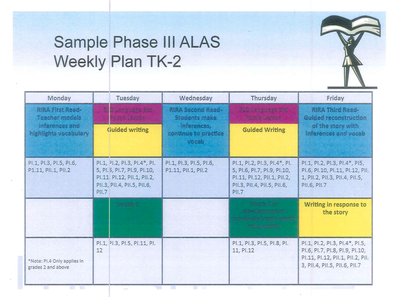 By December, I realized that the ALAS program that I had wanted to analyze and study was evolving before my eyes. What I had understood as the ALAS program in September was only the tip of the iceberg. When the second component of the ALAS program, Repeated Interactive Read Aloud (RIRA) was introduced in December, it added to ALAS a scaffolded comprehension component. And when the How Language Works component was added in March, it added to ALAS an intensive study of the English language. As a result of my realization, I had to reevaluate my leadership project in December. I knew that my team and I could not create a comprehensive system of routine formative assessments for the entire ALAS program. After discussions with my team, I decided to keep the team’s focus on creating and evaluating formative assessments, but only for the academic vocabulary and story structure portion of the ALAS program.
By December, I realized that the ALAS program that I had wanted to analyze and study was evolving before my eyes. What I had understood as the ALAS program in September was only the tip of the iceberg. When the second component of the ALAS program, Repeated Interactive Read Aloud (RIRA) was introduced in December, it added to ALAS a scaffolded comprehension component. And when the How Language Works component was added in March, it added to ALAS an intensive study of the English language. As a result of my realization, I had to reevaluate my leadership project in December. I knew that my team and I could not create a comprehensive system of routine formative assessments for the entire ALAS program. After discussions with my team, I decided to keep the team’s focus on creating and evaluating formative assessments, but only for the academic vocabulary and story structure portion of the ALAS program.
At the time I began the leadership project, I had no idea about the multi-layered, time intensive process of measuring a curriculum’s effectiveness. I also had not realized that regardless of the effectiveness of the program, there would be other factors such as fidelity of implementation that would influence the success of a newly adopted curriculum. In addition, because LESD introduced small portions of the ALAS program at a time, I did not have the comprehensive grasp of the curriculum that would be required to involve parents in the process. Being aware of all of these issues now, I can envision working with a team of teachers to come up with efficient in-class formative assessments to differentiate instruction to meet the specific needs of English language learners for the following year.
Data/Evidence
September - December
Before creating formative assessments and modifying our teaching, my teammates and I discussed the actual teaching and logistics of the vocabulary lesson plans that were provided to us by the Educational Services department. We discussed and planned out how we would teach the lessons and returned each week to discuss aspects of the lesson plan template that we needed to refine in our implementation. Sample ALAS Lesson Plan
For example, for most of my teammates, we needed to refine how we would encourage and monitor authentic conversations during the partner talk portion of the lesson. We committed to following the lesson plan format with fidelity and used sentence frames to facilitate conversations. Then, we used a grid system to help us keep log of which student was using the target academic vocabulary. With this simple tool, I was able to formatively assess student talk. Record Keeping Grid
We committed to following the lesson plan format with fidelity and used sentence frames to facilitate conversations.
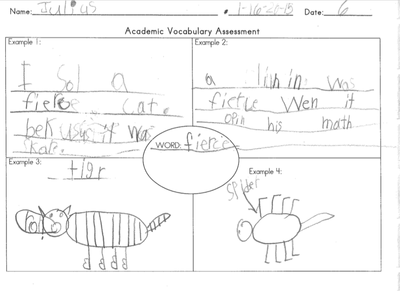 In addition to the on-the-spot oral formative assessments during lessons, my team and I created a word study sheet so that students could draw and write about their knowledge of the learned vocabulary word. When we first began using the formative assessment sheet, students were mainly drawing the understanding of the vocabulary. However, as the year progressed and students’ literacy skills grew, my team had to create several versions of the formative assessments. These word study sheets provided another form of formative assessments that help modify our teaching of students, not only in the ELD block but also in other literacy blocks throughout the day. Formative Assessment 1 Formative Assessment 2 Formative Assessment 3
In addition to the on-the-spot oral formative assessments during lessons, my team and I created a word study sheet so that students could draw and write about their knowledge of the learned vocabulary word. When we first began using the formative assessment sheet, students were mainly drawing the understanding of the vocabulary. However, as the year progressed and students’ literacy skills grew, my team had to create several versions of the formative assessments. These word study sheets provided another form of formative assessments that help modify our teaching of students, not only in the ELD block but also in other literacy blocks throughout the day. Formative Assessment 1 Formative Assessment 2 Formative Assessment 3
December- Present
 When the Repeated Interactive Read Aloud (RIRA) prong of the ALAS program was introduced in December, my team and I were able to extend our formative assessments of student talk and understanding of the vocabulary word to include story structure. This prong of the ALAS program embedded the vocabulary words within the context of the entire narrative and helped students make inferences as they sequenced the stories. Repeated Interactive Read Aloud Sample Lesson
When the Repeated Interactive Read Aloud (RIRA) prong of the ALAS program was introduced in December, my team and I were able to extend our formative assessments of student talk and understanding of the vocabulary word to include story structure. This prong of the ALAS program embedded the vocabulary words within the context of the entire narrative and helped students make inferences as they sequenced the stories. Repeated Interactive Read Aloud Sample Lesson
Each week, a story was read three times, giving English Language learners ample time to understand the context of the vocabulary words. My team and I continued to take anecdotal notes on-the-spot on student conversations, noting correct understanding of vocabulary words and story structure and made immediate modifications. We also developed a retelling formative assessment sheet that allowed us to quickly assess whether a student could retell the story using the academic vocabulary. Retell Formative Assessment
During a meeting in January, my teammates and I discussed how we could keep a very simple comprehensive record of students’ understanding of vocabulary and story structure. One of my teammates created a document that we used to keep a log of student progress. We used this tool to keep a comprehensive record of student progress and used data to differentiate instruction as much as we could in the ALAS block. After having implemented all prongs of the ALAS program, this tool can be adapted and used more effectively next year. Comprehensive Log
In LESD, the CELDT test is given once in the beginning of the year, so I am not able to use that data to assess EL students’ growth in English proficiency until the beginning of the 2015-2016 school year. However, our school uses the Star Early Literacy program and I have used its results to monitor language growth in students. Although the Star Early Literacy tests are not perfectly aligned to the ALAS program, Individual Annual Growth reports on Star Early Literacy indicated that most of the 16 EL students made positive overall growth. In addition, I compared beginning of the year Star Early Literacy Score Distribution report data to the current data. The results indicated that many of the EL students made growth in the vocabulary portion of the test. However, these students could have made this type of progress regardless of the ALAS program this year. Star Early Literacy Vocab Jan Star Early Literacy Vocal May
"These days the kids notice the academic vocabulary when they come up in other content areas."
The teachers on my team noticed anecdotal evidence of the success of the ALAS program. As I had projected as a medium-term goal, teachers noticed student engagement and excitement for the ALAS program. All of my teammates stated that most of the students really enjoyed ALAS time. “These days the kids notice the academic vocabulary when they come up in other content areas,” was one of the comments of my teammates. Others have always shared that they have noticed students using academic vocabulary in their dialogues, both academic and personal. The results of a Teacher Survey indicated that most of the primary grade level teachers felt that the students were participating in accountable partner talk, using correct sentence structures and incorporating academic vocabulary in other academic settings. Many teachers communicated through the survey a need for differentiated instruction of EL students according to proficiency levels, more collaborative opportunities for teachers and an overall desire to spend more time and go deeper into the selected weekly texts. Fortunately, during one of the last district professional development days on ALAS, all primary teachers were able to share these suggestions and thoughts with the Educational Services department. Teacher Survey
Overall, the leadership project provided the team members with a valuable opportunity to collaborate and reflect upon our practices in the new ALAS program. The formative assessment tools we created were used effectively to inform teachers of student progress. The team members as well as the primary level teachers at my site felt positive about the ALAS program’s comprehensive approach. The formative assessment process that the team went through informed our practice throughout the year and facilitated our implementation of the program.
Limitations and Improvements
Due to the fact that the ALAS program ran on a schedule set by the district, it was difficult to use information from the formative assessments to modify the lessons for students at another ALAS time. In addition, without leveling students into language proficiency level groups, which our site did not do, the spectrum of ability levels within each class made it difficult to respond effectively to information gathered from formative assessments. Another limitation of my leadership project was the difficulty of measuring ALAS program’s effectively in a systematic way. Administration of the CELDT can measure the long-term success of the ALAS program. However, the CELDT is an exam given only once a year, and I will not able to obtain information on this year’s EL students’ growth in English language proficiency until early next school year. Additionally, the use of Star Early Literacy scores were helpful, however, it was not sufficient nor specific in measuring the work done in the ALAS program.
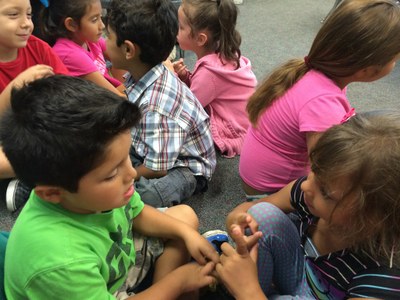 For future analysis of the ALAS program, I would choose a sample group of EL students in the beginning of the year, representing the various proficiency levels on the CELDT. My team would continue our revision work of the various formative assessments but focus our study on the sample group of students. This way, we would have a manageable number of students in a control group with whom we could conduct formative assessments to scaffold ELD instruction. In addition, we would conduct parent surveys of the sample group throughout the school year and chart their thoughts and suggestions. To produce stronger data reflecting the effectiveness of the ALAS program, I would enlist teachers at different grade levels so that we could participate in a longitudinal study of EL student achievement.
For future analysis of the ALAS program, I would choose a sample group of EL students in the beginning of the year, representing the various proficiency levels on the CELDT. My team would continue our revision work of the various formative assessments but focus our study on the sample group of students. This way, we would have a manageable number of students in a control group with whom we could conduct formative assessments to scaffold ELD instruction. In addition, we would conduct parent surveys of the sample group throughout the school year and chart their thoughts and suggestions. To produce stronger data reflecting the effectiveness of the ALAS program, I would enlist teachers at different grade levels so that we could participate in a longitudinal study of EL student achievement.
My Leadership Role
As I reflect back on this project, I am struck with the realization that being an effective, democratic leader requires authentic collaboration with teachers. At first, I was uncertain about my leadership role in analyzing the ALAS program. I was no expert. Every teacher in the district was learning about the ALAS program at the same time. I felt that I had no extra knowledge that would help me lead a group of extremely intelligent professionals on my team. Even though I had adhered to a socially just perspective in teaching, my frame of mind about leadership had still been more closely aligned with the traditional kind. The setbacks and the evolution of my leadership project forced me to bare my weaknesses and open myself up to my team members. This naturally created a distributive, democratic style of leadership within the group and as a result really invigorated our conversations about ELD and our students. We had discussions about ELD/ELA Frameworks and debated the effectiveness of the ALAS program in our district. Our conversations often led us to discussion about equity in our schools and really helped us develop an unofficial vision of what we want our work to represent in our grade level. As a leader this year, I guided my team in the creation of and implementation of several formative assessment pieces for our instruction. In addition, I facilitated the modifications of these assessments and the corresponding instructional modifications. This collaborative opportunity developed my vision for creating a school community that places importance on dialogue and debate in a non-hierarchical framework.
Leadership Project and Final Thoughts
As mentioned previously, one of the most valuable lessons I gained from this process was the value of dialogue and communication through a safe, democratic process. Rather than use a hierarchical leadership model, school leaders need to keep in mind that adult learners are also self-directed and value relationships. A distributive, democratic approach of leadership that provides teachers with opportunities to communicate, give each other feedback, and share diverse perspectives in a safe space is crucial in analyzing new programs such as the ALAS curriculum. Furthermore, I learned that in developing a quality project, the pre-planning process of the logic model was extremely useful in visualizing my goals and desired outcomes. Regardless of whether the logic model remained unchanged throughout the process, it was helpful in keeping my goals and rationale for the project grounded. Another tool that I used to help push forward my project was the notion of Plan-Do-Study-Act (PDSA) cycles focused on a small action of change. When my team and I created and used a formative assessment sheet, we always studied whether it was effective in measuring our specific students’ knowledge through a PDSA cycle. The result of our study and discussions almost always led to a revised version of another formative assessment form. This practice of focusing on a very small change and running PDSA cycles would be something I would use consistently as a school leader.
CAPEs Connection
My activities in implementing the Leadership Project connects to the following CAPEs:
CAPE 1 (Developing and Articulating a Vision of Teaching and Learning Consistent with LEA’s Vision): My vision was to provide best ELD practices by creating formative assessments to analyze the ALAS program, consistent with LESD’s vision to provide equitable academic access to EL learners through the ALAS program.
CAPE 2 (Developing Shared Commitment to Vision): I led my Leadership project team members to collaborate and develop a commitment to implement ALAS lessons with fidelity. Our shared commitment was aligned to the district’s ELD goals.
CAPE 3 (Leading by Example to Promote Implementation): In terms of equity and issues language and access, ALAS implementation has allowed me to talk to my team as well as the ELD coordinator at the district office about providing equitable, accessible practices for EL learners.
CAPE 4 (Sharing Leadership with Others): The entire ALAS analysis this year has been marked by distributed leadership and engagement of team members is problem solving when the process ran into setbacks.
CAPE 5 (Promoting Implementation of K-12 Standards, Pedagogical Skills, Effective Instructional Practices and Student Assessments for Content Instruction): Through the Leadership project, I gained a lot of knowledge about the ELA/ELD frameworks as well as the CCSS. As a result, my team and I were able to articulate effective instructional practices and discuss assessment for EL students.
CAPE 6 (Evaluating, Analyzing, and Providing Feedback on the Effectiveness of Classroom Instruction to Promote Student Learning and Teacher Professional Growth): Using the ELD standards within the framework of an ALAS lesson, I used a focus-point observation process to analyze effectiveness of teaching. I participated in constructive conversation with my teammate regarding her practice.
CAPE 7 (Understanding of the School and Community Context, Instructional Implications of Cultural/Linguistic, Socioeconomic, and Political Factors): Understanding the needs of EL students, I guided my team in implementing the ALAS curriculum with fidelity. When there were concerns raised about components or implementation of ALAS curriculum, I was able to inform my team about the ELD non-compliance issue our district was working toward.
CAPE 9 (Working with Others to Identify Student and School Needs and Development of Growth Plan): I involved my grade level team and the assistance of our ELD coordinator to implement ALAS strategies to fortify our district’s new ELD program.
CAPE 10 (Implementing Change Strategies Based on Current, Relevant Theories and Best Practices in School Improvement): Understanding the theories of second language acquisition, I worked with my team and discussed our practices during the ALAS program as well as possible modifications reflecting results from formative assessments
CAPE 12 (Instituting Collaborative, Ongoing Process of Monitoring/Revising Growth Plan based on Outcomes): During the entire first year of ALAS implementation, I used formative assessments and analysis around the implementation of ALAS program to monitor progress of the implementation as well as the language growth of EL students.
CAPE 13 (Modeling Life Long Learning and Professional Growth): Through participating in the PLI program, in professional development provided by the district, and by personal study of the ELA/ELD curriculum, I committed to professional learning throughout the school year. I also used these multiple sources of data to inform my professional growth plan in conducing my Leadership project.
Next Steps
My Leadership project will most definitely evolve next year. In my attempt to analyze my district’s newly adopted ELD curriculum, ALAS, I have gained so much knowledge about teaching English language learners. In my research, I have learned how the ELA/ELD framework addresses equity for English language learners. I hope to use this knowledge to improve my district’s ALAS program and its implementation process. This last statement has significant implications for me because I will be serving my district in a different role next year, transitioning from a classroom teacher to English Language Instructional Resource Teacher (ELIRT).
Specifically, the biggest transformation for my Leadership project will be that I will be able to analyze and reflect upon the ALAS program from an out of the classroom perspective and more on a district level. Because of my new role being directly involved in the ALAS implementation, I project that I will have better understanding of the entire curriculum and its connection to equity and social justice. A short term goal I have set is to take classes and earn a BCLAD certification in Spanish. I hope that I can realize this goal in the near future. At this point, the road ahead is uncertain. However, I am certain that I will grow and refine myself as a social justice educator.

